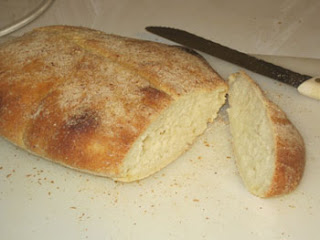To recap from yesterday, I mixed 200g of 00 flour with 200g of water, containing a little sugar and a teaspoon of yeast. I let that sit in the fridge overnight.
Today, I've taken it out, let it come to room temperature, then added 110g more flour, 4g salt and 20g olive oil, and kneaded that quite sloppily. What I should have realised before now is that when you've finished kneading a wet dough a tiny amount of dry flour on the surface will make it much more shapeable, without seriously affecting the mixture. So this dough is now (1130) very shallowly coated with wholemeal flour, formed into a ciabatta kind of shape, and proving.
Update and verdict
 |
| It's Italian, right? |
Meanwhile, on the question of authenticity, I've looked at Italian wikipedia's bread article. You don't need to be able to read Italian to realise the huge variety of breads listed there. Ciabatta's not among them! The other point about this list is that it enables anyone to claim that virtually any bread they make has a propa Italian model (except maybe Chorleywood white sliced).

No comments:
Post a Comment